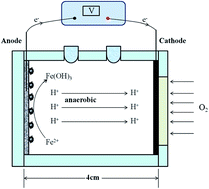Synchronous recovery of iron and electricity using a single chamber air-cathode microbial fuel cell†
Abstract
In recent years, microbial fuel cell (MFC) technology has become an attractive option for metal recovery/removal at the cathode combined with electricity generation, using organic substrates as electron donor at the anode. With no organic substrate supply, a single chamber air-cathode MFC was used to synchronously recover metal and electricity from a real stream containing high-strength metal, sulfate, strong acid and acidophilic chemoautotrophic bacteria (ACB). Instead, ferrous ions were used as electron donor which made the single chamber air-cathode MFC applicable for the (bio)leachate and mining/metallurgical stream sites possibly lacking organics. We showed that 71.8% iron was recovered, and 95.9% ferrous ions were removed from a real iron-laden stream. At the same time, 360.1 mV cell voltage was achieved with 88.1% of coulombic efficiency. In the presence of ACB microbes, the iron recovery and power density were increased by 8.6% and 29.2%, respectively, via promoting the anode electron transferring and preventing sulfur passivation of electrodes. Iron in the form of FeOOH (goethite) was recovered mainly at the anode via the ferrous oxidization to Fe(OH)3. At the cathode, ferrous ions directly combined with oxygen and electrons into FeO, and further into Fe2O3. It was prospective at sites lack of organics to synchronously recover metals and electricity from real metal-laden streams using single chamber air-cathode MFC technology.



 Please wait while we load your content...
Please wait while we load your content...